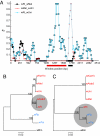The mosaic genome structure of the Wolbachia wRi strain infecting Drosophila simulans
- PMID: 19307581
- PMCID: PMC2659715
- DOI: 10.1073/pnas.0810753106
The mosaic genome structure of the Wolbachia wRi strain infecting Drosophila simulans
Abstract
The obligate intracellular bacterium Wolbachia pipientis infects around 20% of all insect species. It is maternally inherited and induces reproductive alterations of insect populations by male killing, feminization, parthenogenesis, or cytoplasmic incompatibility. Here, we present the 1,445,873-bp genome of W. pipientis strain wRi that induces very strong cytoplasmic incompatibility in its natural host Drosophila simulans. A comparison with the previously sequenced genome of W. pipientis strain wMel from Drosophila melanogaster identified 35 breakpoints associated with mobile elements and repeated sequences that are stable in Drosophila lines transinfected with wRi. Additionally, 450 genes with orthologs in wRi and wMel were sequenced from the W. pipientis strain wUni, responsible for the induction of parthenogenesis in the parasitoid wasp Muscidifurax uniraptor. The comparison of these A-group Wolbachia strains uncovered the most highly recombining intracellular bacterial genomes known to date. This was manifested in a 500-fold variation in sequence divergences at synonymous sites, with different genes and gene segments supporting different strain relationships. The substitution-frequency profile resembled that of Neisseria meningitidis, which is characterized by rampant intraspecies recombination, rather than that of Rickettsia, where genes mostly diverge by nucleotide substitutions. The data further revealed diversification of ankyrin repeat genes by short tandem duplications and provided examples of horizontal gene transfer across A- and B-group strains that infect D. simulans. These results suggest that the transmission dynamics of Wolbachia and the opportunity for coinfections have created a freely recombining intracellular bacterial community with mosaic genomes.
Conflict of interest statement
The authors declare no conflict of interest.
Figures




References
-
- Werren JH, Baldo L, Clark ME. Wolbachia: master manipulators of invertebrate biology. Nat Rev Microbiol. 2008;6:741–751. - PubMed
-
- Stouthamer R, Breeuwer JA, Hurst GD. Wolbachia pipientis: microbial manipulator of arthropod reproduction. Annu Rev Microbiol. 1999;53:71–102. - PubMed
-
- Werren JH, Zhang W, Guo LR. Evolution and phylogeny of Wolbachia: reproductive parasites of arthropods. Proc Biol Sci. 1995;261:55–63. - PubMed
-
- McGraw EA, O'Neill SL. Evolution of Wolbachia pipientis transmission dynamics in insects. Trends Microbiol. 1999;7:297–302. - PubMed
-
- Bourtzis K, Braig HR, Karr TL. In: Insect Symbiosis. Bourtzis K, Miller TA, editors. Boca Raton: CRC Press; 2003. pp. 217–246.
Publication types
MeSH terms
Substances
Associated data
- Actions
- Actions
LinkOut - more resources
Full Text Sources
Other Literature Sources
Molecular Biology Databases

